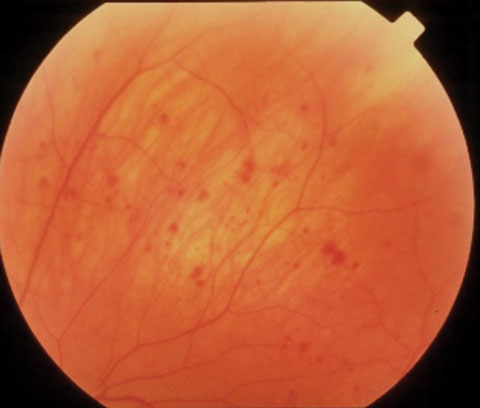 |
| This study found that almost a quarter of newborns have a retinal hemorrhage. Photo: Leticia Rousso, OD, and Joseph Sowka, OD. Click image to enlarge. |
Birth-related retinal hemorrhages may be common in healthy newborns, as a team of researchers from Korea found this condition was prevalent in roughly 23% of infants. Their investigation, published in PLoS One, cited a strong link between retinal hemorrhages and normal spontaneous vaginal delivery. The authors also reported that the newborns’ retinal hemorrhages were usually bilateral, intraretinal and distributed posterior to the retina, but severe cases had unique characteristics including both macular and optic nerve involvement, Roth spots and foveal involvement.
The authors screened approximately 56,000 newborns from 61 OB/GYN hospitals from 2017 to 2019 using telemedicine combined with widefield digital retinal imaging.
Birth-related retinal hemorrhages seemed to occur due to the compression of the head during passage through the birth canal, the authors explained. Specifically, an acute increase in intracranial pressure resulting from compression inhibited central retinal venous flow and subsequently resulted in an acute change in central retinal arterial pressure, they added.
“In other words, the retina of newborns becomes more vulnerable to hemorrhages during vaginal delivery,” the authors wrote in their paper.
Of all the infants born with retinal hemorrhages, approximately 94% were delivered vaginally compared with just roughly 6% who were delivered via Caesarean section. While about 40% of newborns delivered via natural childbirth developed retinal hemorrhages, only about 3% delivered via Caesarean had the condition.
Other key study findings included:
Among the roughly 56,200 newborns in the study, about 13,000 had birth-related retinal hemorrhages.
Normal spontaneous vaginal delivery showed the highest association with the condition.
Bilateral retinal hemorrhages (65%) were more common than unilateral ones (35%). However, unilateral retinal hemorrhages (57%) were more common than bilateral ones (44%) in the minimal group.
Retinal hemorrhages showed no laterality differences between the two eyes. Most were intraretinal (87%), and 2,328 (32%) eyes with preretinal hemorrhage were observed in the severe group.
Zone I retinal hemorrhages were common in the minimal (99.75%), mild (99.86%) and moderate (98.92%) groups.
Zone I and II retinal hemorrhages were common in the severe group (66%).
Retinal hemorrhages in zone III were rare (0.03%).
Most newborns in the minimal and mild groups had no macular and/or optic nerve involvement. On the other hand, this finding was common in the severe group (97%).
The present study did not assess visual prognosis in these cases but the authors did mention that “future long-term longitudinal studies would be required to elucidate the prognosis of newborns with severe RHs.”
Cho IH, Kim MS, H NH, Kim SY. Birth-related retinal hemorrhages: The Soonchunhyang University Cheonan Hospital universal newborn eye screening (SUCH-NES) study. PLoS One. November 9, 2021. [Epub ahead of print]. |


